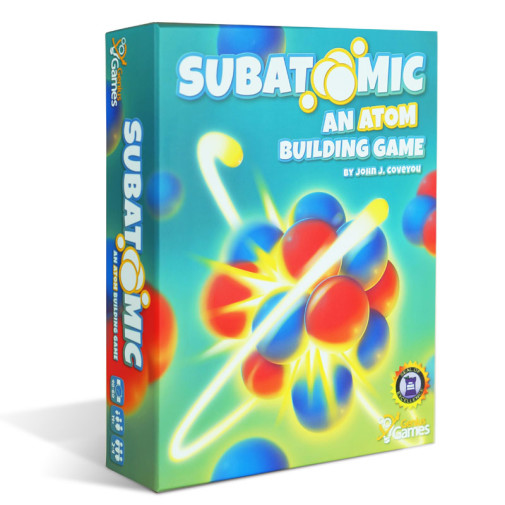We use cookies to make your experience better. To comply with the new e-Privacy directive, we need to ask for your consent to set the cookies. Learn more.
Subatomic: An Atom Building Game(2nd Edition)
- Small parts. Not for children under 3 years.
Subatomic combines particle physics and chemistry for players to try to build different elements. Each player starts the game with their own small deck of cards Up Quarks, Down Quarks, and Photo/Gamma Ray that they use to make subatomic particles (protons, neutrons, electrons), then use those to build elements. Your game comes with 44 Quark and Photon cards, 46 Proton, Neutron, and Electron Cards, 24 Element Cards, 41 colored cubes, 12 clear beads, 32 energy tokens, 4 player mats, first player marker, game board, and 7 bonus tiles. Each player's turn is two steps playing cards to take action, and fill any empty spots created by your turn. Players score points by gathering Elements and by meeting goals. Put your physics, chemistry, and strategy skills into action in Subatomic.
Subatomic is a deck-building game about building elements from subatomic particles! Players begin the game with a small deck of quarks and photons. Each turn, players draw a new hand of cards and decide to either build up their atom to score points, or buy stronger cards for their deck. Players use their quarks and photons to build protons, neutrons and electrons.
They then decide to either (1) place these subatomic particles within the atom on their player mat (racing to build up an entire atom which will score them points), or (2) use them to buy proton, neutron and electron cards which go into their deck (making their deck more powerful and allowing them to build atoms even faster in the future!).
Players may also "hire" famous scientists like Marie Curie, Niels Bohr, Maria Goeppert-Mayer and Albert Einstein. Players use scientists to break the standard rules of the game, like turning energy into matter and replicating cards played by other players!
Subatomic is great for the science classroom or a game night with family and friends. Subatomic is easy to learn, but exciting to master and encourages strategic timing and optimizing available resources. All the concepts covered in Subatomic are concepts that would be introduced in a basic high school level chemistry course. And it does so in a way that is fun and intuitive for everyone!
Homeschool Chemistry Curriculum, Workbooks, Lab Materials, Kits, Games, and Chemistry Lab Supplies
| Product Format: | Other |
|---|---|
| Brand: | Genius Games |
| Grades: | 5-AD |
| EAN/UPC: | 653341737502 |
| Length in Inches: | 11.5 |
| Width in Inches: | 8.75 |
| Height in Inches: | 2.5 |
| Weight in Pounds: | 2.3 |

